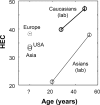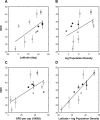Head-Eye Coordination Increases with Age and Varies across Countries
- PMID: 26421683
- PMCID: PMC4623845
- DOI: 10.1097/OPX.0000000000000709
Head-Eye Coordination Increases with Age and Varies across Countries
Abstract
Purpose: Head movements in older people may contribute to their dizziness and equilibrium problems. Head gain is the ratio of head movement to total movement (head + eye) when executing a saccade to an eccentric target. Two studies have investigated the relationship between head gain and age but have provided conflicting results.
Methods: We report head gain data collected from research laboratories and optician stores. Our sample sizes are much larger (n = 657 for laboratory, n = 64,458 for optician stores), permitting more detailed analyses.
Results: The head-eye coefficient, expressed as 100 times the square root of head gain, was bimodal with one mode of primarily eye movers and one mode of eye-and-head movers. Head-eye coefficient increased with age and was invariant with eye correction and gender. We also found an effect of nation that seemed associated with gross domestic product or by latitude (in the northern hemisphere) and log population density.
Discussion: Assuming that head movements and visual distortions contribute to dizziness and equilibrium problems, our study suggests that customizing eyewear based on age and country may help in reducing the prevalence of problems associated with head and/or eye movements.
Figures






Similar articles
-
Eye-head coordination in moderately affected Huntington's Disease patients: do head movements facilitate gaze shifts?Exp Brain Res. 2009 Jan;192(1):97-112. doi: 10.1007/s00221-008-1559-6. Epub 2008 Sep 20. Exp Brain Res. 2009. PMID: 18807023
-
Age-related changes in head and eye coordination.Neurobiol Aging. 2004 Nov-Dec;25(10):1377-85. doi: 10.1016/j.neurobiolaging.2004.02.024. Neurobiol Aging. 2004. PMID: 15465636 Clinical Trial.
-
Amplitudes of head movements during putative eye-only saccades.Brain Res. 2005 Dec 14;1065(1-2):68-78. doi: 10.1016/j.brainres.2005.10.029. Epub 2005 Nov 21. Brain Res. 2005. PMID: 16300748 Clinical Trial.
-
Eye movements of vertebrates and their relation to eye form and function.J Comp Physiol A Neuroethol Sens Neural Behav Physiol. 2015 Feb;201(2):195-214. doi: 10.1007/s00359-014-0964-5. Epub 2014 Nov 15. J Comp Physiol A Neuroethol Sens Neural Behav Physiol. 2015. PMID: 25398576 Review.
-
Neural mechanisms of visual orienting responses.Prog Brain Res. 1996;112:1-15. doi: 10.1016/s0079-6123(08)63317-8. Prog Brain Res. 1996. PMID: 8979817 Review. No abstract available.
References
-
- Afanador AJ, Aitsebaomo P, Gertsman DR. Eye and head contribution to gaze at near through multifocals: the usable field of view. Am J Optom Physiol Opt 1986; 63: 187– 92. - PubMed
-
- Fuller JH. Head movement propensity. Exp Brain Res 1992; 92: 152– 64. - PubMed
-
- Bard C, Fleury M, Paillard J. Different patterns in aiming accuracy for head-movers and non-head movers. In: Berthoz A, Vidal PP, Graf W, eds. The Head-Neck Sensory-Motor System. New York, NY: Oxford University Press; 1992; 582– 6.
-
- Stahl JS. Amplitude of human head movements associated with horizontal saccades. Exp Brain Res 1999; 126: 41– 54. - PubMed
-
- Stahl JS. Eye-head coordination and the variation of eye-movement accuracy with orbital eccentricity. Exp Brain Res 2001; 136: 200– 10. - PubMed
Publication types
MeSH terms
LinkOut - more resources
Full Text Sources
Medical

